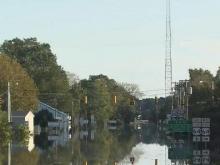- Fake job seekers are flooding the market, thanks to AI
- One set of evacuation orders lifted in Caldwell County after wildfire contained
- 'We gutted every building' | Chimney Rock rebuilding after Hurricane Helene
- 'We gutted every building' | Chimney Rock rebuilding after Hurricane Helene
- Debris from Hurricane Helene provides fuel, complicates containment for spring wildfires
NC State study finds levees are at risk with frequent flooding

Raleigh, N.C. — New research out of North Carolina State University is showing how the United States’ aging levee system could have hidden dangers inspectors may not be able to see.
Researchers chose to use the levee in Princeville as a case study. Princeville was nearly destroyed during Hurricane Floyd in 1999 and suffered heavy damage during Hurricane Matthew in 2016.
“With the climate change, this kind of flood events is occurring more frequently,” said Roshown Jadid, a civil engineering Ph.D. candidate and one of the authors of the study.
“Having a better understanding of how they perform and how we can assess when they might start to fail is critical,” said Brina Montoya, an NC State civil engineering associate professor.
The research team gathered data and soil samples and used mathematical equations to show that the Princeville levee has invisible damage deep under the surface that would be hard for Army Corps of Engineers inspectors to see during standard reviews.
“I think the research is able to show quite clearly that repetitive flooding cycles is creating cumulative damage in the levee, so even though from the surface we can’t see what’s happening, inside the levee it’s deforming and straining,” Montoya said.
And since the average age of levees in the United States is 56 years old, this could be dangerous for areas prone to frequent flooding.
Researchers are in the process of using the study’s findings to develop tools that can help figure out which levees will have to be replaced first.
“Our levee system is aging, and this is a very critical time,” Jadid said. “Our research will help them.”
The Princeville levee is scheduled to get an upgrade soon. The Army Corps of Engineers plans to spend nearly $40 million to extend and reinforce the levee.

